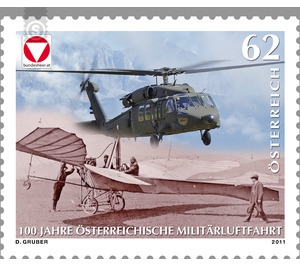100 years - Austria / II. Republic of Austria 2011 - 62 Euro Cent
Theme: Traffic, Transportation & Mobility
| Country | Austria / II. Republic of Austria |
| Issue Date | 2011 |
| Face Value | 62.00 |
| Edition Issued | 300,000 |
| Printing Type | offset |
| Stamp Type | Commemorative |
| Item Type | Stamp |
| Chronological Issue Number | 2279 |
| Chronological Chapter | OOS-OE2 |
| SID | 808042 |
| In 62 Wishlists | |
It was written October 23, 1909, when Emperor Franz Joseph, together with some 300,000 Viennese, senior military and members of the imperial family, watched the performances of Louis Bleriot in his monoplane Type XI - for the first time they had seen a man fly on a plane. Bleriot's enthusiastic reception in Vienna was undoubtedly the visible sign that the powered aircraft had made a breakthrough in Austria-Hungary as well. Of course, the military authorities had previously shown interest in an airplane, but negotiations to buy a Wright device failed because of the price. However, neither the chronic shortage of money nor the distrust of many military against a new type of weapon could stop the progress. Their first aircraft, a (no longer really airworthy) Voisin apparatus, got the army as a gift, in the aftermath came several more pieces of rich, flight-loving patrons. In addition, some officers were willing to buy at their own expense an "airplane" or even build yourself. First, a certain Lieutenant Miescislaus Miller acquired the pilot diploma in June 1910, followed by officers. Of course, these first steps in military aviation could not form the basis for the planned development of aviation in the k.u.k. Be an army. The most important proponent of engine aviation was finally Chief of Staff Conrad von Hötzendorf, who recognized the possibilities of military use already in 1908 and advocated their generous support. So he requested in October 1910, the procurement of 200 aircraft and the training of 400 pilots - his application ultimately resulted in a tender for military aircraft by the army administration. In October 1910 the offer of Ignaz "Igo" Etrich was accepted for the delivery of an "Etrich pigeon" for the price of 25,000 crowns. Also at the company Autoplanwerke Ges.m.b.H. one ordered each a car plane biplane and a Pischof monoplane. On 2 April 1911, the army administration took over the "Etrich Dove", apart from the donations, as the first military aircraft of the k.u.k. Army. Since the pigeon met the conditions, it was decided before the delivery of the two other machines for the purchase of two more pigeons. Finally, on April 19, at the Wr. Neustadt set up the "Flying Machine Instruction Department", and as early as May 1911, the first aviation course began, involving 27 officers. The Austrian military aviation took on human and material form. The motif of the new special stamp captures the pictorial arch of a whole century in an attractive way: It shows both the "Etrich Dove" mentioned above and the most modern military helicopter in Austria, the so-called "Black Hawk".


